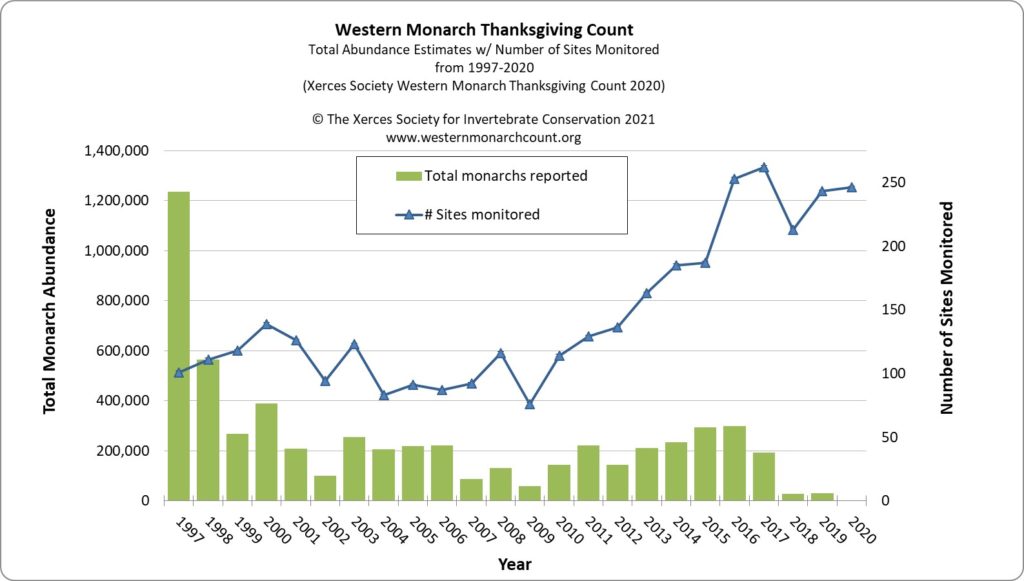Fewer than 2,000 monarch butterflies were counted in California’s overwintering sites this year, a dire indication for the viability of the western migration. The annual Western Monarch Thanksgiving Count surveyed 246 sites with only 1,914 total monarchs counted. Western monarch populations saw previous all-time low counts in 2018 and 2019, with only 30,000 monarchs those years. The 2020 count heightens the urgency of scaling up conservation efforts to prevent the western migration from disappearing altogether.

Western monarchs breed west of the Rocky Mountains and overwinter primarily along the Pacific Coast of California. While a recent study from Emory University shows that the eastern and western populations are genetically the same, lumping the two populations together could come as a detriment to the western monarch. In December 2020 the U.S. Fish and Wildlife Service decided that the monarch butterfly warranted listing under the Endangered Species Act (ESA), but the listing was precluded by other higher priority actions. The ESA is written such that the eastern and western subpopulations of monarchs could not be considered separately for listing, and therefore none of the global populations will receive protections of the Act until it reaches the top of the priority list. But, now is not the time to wait for interventions to help save the western monarch migration. We must work immediately and scale efforts to support the western population by creating breeding habitat, protecting overwintering groves, and spreading awareness throughout the western states. The Monarch Collaborative aims to identify agricultural and conservation practices that support healthy monarch populations and increase awareness of those practices among all stakeholders. Just as the eastern monarch population relies heavily upon the agricultural Midwest as a productive breeding area, the western population relies heavily upon early spring breeding in the agricultural Central Valley of California. It will take a concerted effort from all sectors, including the ag community, to plant, enhance, and protect forage to revive declining pollinator populations. Below is a list of government and non-government organizations, programs, and resources offered to help landowners establish pollinator habitat:
- The U.S. Department of Agriculture
- Practice 327A, Conservation Cover, Pollinators
- Practice 422A, Hedgerow Planting, Pollinators
- The Environmental Quality Incentive Program (EQIP)
- The Agricultural Conservation Easement Program (ACEP)
- The Conservation Stewardship Program (CSP)
- The Conservation Reserve Program (CRP)
- The U.S. Fish and Wildlife Service
- Project Apis m.
- Seeds for Bees cover crop program
- Partnership with Monarch Joint Venture on monarch seed mix
- Contact Wynter, wvaughan@monarchjointventure.org for more information
- Environmental Defense Fund
- Xerces Society
- Pollinator Partnership
You can get more information on these and other resources by visiting the State Planting Resources page on our website. You can also contact the Monarch Joint Venture’s Pollinator Habitat Help Desk at (833) 645-5933 or (833) MILKWEE for more information on planting milkweed and other pollinator habitat on your land.
